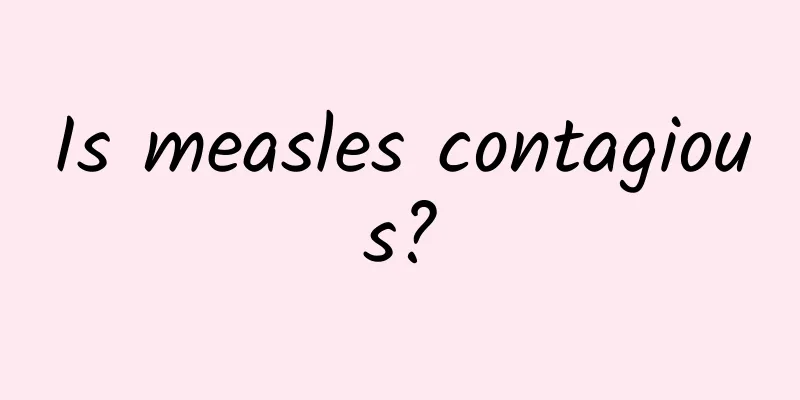Is measles contagious?

|
Measles is similar to eczema and urticaria, and is also a skin disease. After suffering from measles, you must pay attention to the patient's diet and daily travel conditions, because some measles may worsen the patient's condition when exposed to the wind. The main cause of measles is the measles virus, so some babies with low immunity have a high chance of contracting measles. But is the skin disease measles contagious? Measles infection Infection is transmitted through the respiratory secretions of measles patients through the air or contact. You are usually contagious for 5 days before and after the rash appears. Clinical symptoms of measles Children infected with the measles virus begin to develop symptoms after an incubation period of 9 to 12 days. First, fever and general fatigue occur, followed by runny nose, sneezing, coughing and other phenomena. Some children will have symptoms such as tearing eyes and fear of light, and the symptoms worsen day by day. Generally, the rash will begin to appear on the fourth day of fever. One or two days before the rash appears, many white spots as big as needle tips can be found on the oral mucosa. These spots are called "Kopolik spots." Because these spots only appear when measles occurs, the doctor can immediately diagnose measles when he sees "Kopolik spots." Measles rash first appears behind the ears and on the forehead, then gradually spreads to the face, chest, abdomen, back, and finally to the limbs. Three days later, a rash appears and the fever begins to subside. Many children will have gray-brown spots on their skin that last for 1-2 weeks. Measles prevention and vaccines 1. Manage the source of infection: patients should be strictly isolated and contacts should be quarantined for 3 weeks; during the epidemic, nurseries, kindergartens and other children's institutions should suspend the pick-up and admission of susceptible children. 2. Cut off the transmission route: pay attention to ventilation in the ward and make full use of sunlight or ultraviolet radiation; medical staff should wash their hands and change their outer clothes after leaving the ward or stay in a well-ventilated place for 20 minutes before contacting susceptible people. 3. Vaccination: The use of live measles vaccine is the most effective and fundamental way to prevent measles. The country now provides measles vaccination with an initial shot at 8 months of age and a booster shot at 6 years of age. Some provinces have set the revaccination schedule at 18 to 24 months. Another inoculation dose is 0.5ml. 4. Passive immunization: Passive immunization should be used for weak, sick, young susceptible children with a history of close contact. Intramuscular injection of immunoglobulin 0.1-0.2 ml/kg and placental globulin 0.5-1.0 ml/kg can prevent the disease if injected within 5 days after contact, and can alleviate symptoms if injected within 6-9 days. The immunity is effective for 3 weeks. |
<<: What to do if your six-month-old baby has recurrent eczema
>>: What to eat is good for the uterus
Recommend
Causes of Iron Deficiency Anemia
Speaking of iron deficiency anemia, it is well kn...
What to do if you have menstrual pain
The most difficult time for women is those few da...
The difference between maca tablets and maca essence tablets
Maca is very rich in trace elements. Studies have...
What kind of fruit is better for myocardial ischemia?
Friends with myocardial ischemia can eat fruits, ...
Hyperthyroidism eye pain can be relieved by doing this
Hyperthyroidism is a very familiar disease for ma...
Can aspirin cure gray hair?
Aspirin is a widely used special medicine for pai...
What to do if hemorrhoids itch? There are ways to relieve itching
Hemorrhoids are a very common disease. The sympto...
Ginger can detoxify aconite
Following the recent honey wine incident, another...
What are the side effects of liver protection drugs?
Many people in our lives have poor liver organs a...
What to do if you have high blood pressure, dizziness and vomiting? There are ways to adjust your diet
In modern life, people are eating more and more u...
What are the dishes that clear heat? These three are the most effective
In daily life, different types of food have diffe...
Blood spots on the body
Blood spots are a very disturbing problem, because...
What to do if you have pericoronitis
Basically each of us has teeth, and teeth often s...
Can trichomoniasis be cured?
Trichomonas vaginitis is a very common gynecologi...
What are the effects and functions of purple garnet?
On the earth, there are many very precious minera...









